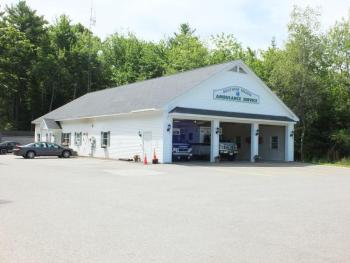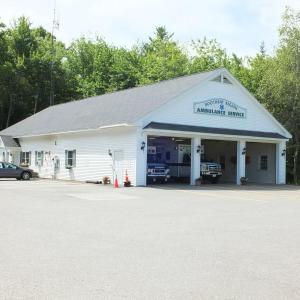Ambulance prepares for ER closure
Ambulance calls have changed dramatically since the days when Sonny Simmons picked up patients in his Cadillac station wagon that did dual duty as hearse and ambulance. Whether a patient arrived at the funeral home or St. Andrews Hospital was mostly up to fate and good driving.
Today, the Boothbay Region Ambulance Service has a paid and volunteer staff approaching 40, who are all licensed emergency medical technicians, its own facility near the Boothbay Town Office and three fully-equipped ambulances.
With the closure of St. Andrews ER, the ambulance service will undergo another evolution. The financial impact of the change is not yet clear, but the service will need more highly trained staff, more training, and the logistics of getting patients from emergencies to the hospital will need to be reworked.
At present, patients are no longer simply driven to the hospital; paramedics and EMTs begin treatment on site and continue treatment en route to the hospital. They resuscitate, manage breathing, start intravenous lines, administer drugs and are in direct contact with an emergency doctor while they head to the nearest hospital. Today’s emphasis on pre-hospital care is often the difference between life and death in an emergency.
The local ambulance service has two crews on duty every day, one crew on duty overnight, and backup EMTs on call. Paramedics, the most highly skilled responders, are available 24 hours a day, seven days a week.
When the ER is replaced by an urgent care center, St. Andrews will lose its hospital license and ambulances will no longer be able to transport emergency patients to St. Andrews.
State protocol directs ambulances to take patients to the nearest appropriate facility in an emergency. Local ambulances will need to transport patients at least to Miles Memorial Hospital in Damariscotta, 19 miles from St. Andrews Hospital in Boothbay Harbor.
The Boothbay Region Ambulance Service gets most of its operating revenues from Medicare/Medicaid and insurance reimbursements (about 86 percent of total revenues in 2010). The remainder comes from local towns. Medicare sets the standard for reimbursement, establishing a base rate to which mileage is added. Ambulances are paid only for the time a patient is in the ambulance; return trips and on-call patient assistance without a transport are not reimbursed.
Fundraising has been used over the years to cover the cost of equipment replacement (a new ambulance fundraiser is currently underway).
In addition to responding to 911 calls, ambulances also transport patients from hospitals to other facilities.
Transfers from hospitals to other facilities tend to offset the costs of emergency calls, Ambulance Service Operations Supervisor and paramedic Scott Lash said. “A lot of services have added routine transfers to their scope of work to generate revenues,” he said.
Lash estimated the ambulance service made about $200,000 from transfers from St. Andrews last year. Transfers greatly increased for the ambulance service in 2010 when St. Andrews stopped admitting acute care patients and patients had to be transported to other hospitals by ambulance. The additional revenues from these transports have allowed the ambulance service to increase and maintain staff.
What will the changes mean to patients?
The shift to Miles will extend transport times for most peninsula emergencies but will not affect the time it takes ambulances to arrive on the scene of an emergency, a critical factor in patient survival.
Representative Les Fossel (R-Alna) serves on the Legislature’s Health and Human Services Committee and is concerned about healthcare costs in the state. “Emergency care has been moving closer and closer to the place where the emergency occurs,” Fossel said during a telephone interview August 12. “People need to understand that what an ER was used for 10 years ago is not what it is needed for today.”
Lincoln County Healthcare Emergency Department Director Dr. Tim Fox said he does not believe the longer transport time will be as significant to patient survival as some residents fear.
“If someone cannot be stabilized in an ambulance, usually it is difficult to stabilize them anywhere. The expertise and equipment to handle emergencies already exists at the Boothbay Region Ambulance Service. What they need now is more resources to deal with longer transport times,” Fox said.
In Maine and other rural parts of the nation, long ambulance transport times are not uncommon, Atlantic Partners EMS Executive Director Rick Petrie said. Atlantic Partners EMS provides support, leadership and collaboration for local EMS providers over much of the state and will help with the local ER transition. Petrie said there are currently no data available on the effect of transport time on patient outcome.
“For the overwhelming majority of calls, transport time doesn’t play into survival,” Petrie said. “There is a way to adjust to this change and we are working on it. The change is hard, but there is a very dedicated group of staff at the ambulance service and hospital who are working on this.”
Lash said although long transport times are the norm in other areas, the difference for this community is the norm has always been a local hospital. “Any reduction in local healthcare services is of concern,” he said.
The road ahead
The increasing emphasis on emergency care “pre-hospital” has resulted in more saved lives, but it has also driven ambulance services to rely more on professional staff and less on volunteers. That shift has increased the ambulance service’s capabilities but has also raised yearly expenses.
Lash said emergency treatment protocols, training costs and public expectations have all driven the evolution to an ambulance crew composed mostly of highly-trained professionals.
“Ambulance services are moving to hire full-time staff, but it takes time to build that cost into budgets,” Lash said. Since taking on his new management position for the ambulance service in December, Lash has been working on staffing, logistical and budget issues with an eye to meeting local needs. His efforts shifted into high gear with the announcement of the ER closing.
Now Lash and Ambulance Service Chairman Robert Ham are working to figure out how the ambulance service can adapt to the ER change and have been meeting with Lincoln County Healthcare since July to figure out how they can help in this process.
Including return trips, Lash estimates the service’s call time and mileage could triple. This year, 49 percent of local ambulance calls averaged five miles or less from the scene to the hospital and the average total run mileage was 19 miles, Lash said. With the shift to Miles ER, average run times are expected to increase from 30 minutes to 1.5 to 1.75 hours.
With the move to Miles ER, Boothbay Region Ambulance Service will need more paid staff on duty. “We are going to need more people at the higher license levels to take care of patients for longer periods of time,” Ham said. “Volunteers that have been able to leave work to respond for 15 to 20 minutes are less likely to be able to leave work for the hour or more it will take to get to Miles and back.” Lash estimated the additional salary cost at about $100,000.
Lash said they now plan to keep rather than salvage the oldest ambulance in the fleet when its replacement arrives, bringing the local fleet up to four vehicles. The extra vehicle will provide back-up for the longer time spent off the peninsula.
How Boothbay Region Ambulance Service’s revenue stream will be affected by the ER shift is less clear. The ambulance service will no longer transfer patients out of St. Andrews, a service that provided them about $200,000 last year. However, total call volume may increase because people who may have driven themselves to St. Andrews may choose an ambulance for the longer trip to the Miles.
There is also the expectation of increased transfers from Miles, but at present, how much that may offset lost revenues is unknown.
Longer travel times also mean more wear and tear on ambulances and may boost insurance rates. The ambulance service replaces vehicles about every seven years now; Lash said ambulance lifetime could be less than five years with the shift.
Ham also worries about the increased risk to ambulance staff from the change.
“Obviously, there is a public safety issue with emergency transports. With the drive to Miles, it’s a bigger risk to us because there is much more exposure on the longer ride,” Ham said.
The ambulance service’s yearly budget cycle runs from July 1 through June 30 and town appropriations have been set for the 2012-13 fiscal year. “We’ve had no opportunity to budget for this,” Ham said.
Lincoln County Healthcare support
Both Lincoln County Healthcare CEO James Donovan and Board of Trustees Chairman Peter Mundy have promised support for the ambulance service and help with the transition. “We are committed to maintaining the EMS in this community,” Donovan said. Lincoln County Healthcare provides $50,000 each year in support of LifeFlight and will continue to do so, Donovan said. The helipad and dock at St. Andrews will be maintained.
Lash and Ham met with Emergency Department Director Fox and Hospital Operations Director Cindy Leavitt within hours of MaineHealth’s approval of the ER change on August 2. The group will work over the coming months to address the ambulance service’s fiscal, training and equipment needs and to develop protocols to ensure patient safety for the longer ride.
Although ambulances are not expected to be able to deliver patients to the urgent care center at St. Andrews, Fox is investigating the possibility of a local exception to this rule. Leavitt said she is looking at transportation alternatives for patients who call 911 because they have no other ride but are not facing a true emergency.
Lash said about 5 percent of ambulance calls are “life and death” emergencies. Non-emergency 911 calls unnecessarily tie up skilled emergency crews, but they also provide income. “We don’t want to encourage everyone to go by ambulance, but if everyone goes by car and taxi, you eliminate so much that you hurt the emergency system,” he said.
Lash said providing alternative transportation for non-emergencies will be complicated and challenging. He said the service is considering relying more on emergency management dispatchers to prioritize the level of their staff response to calls.
For more on changes at St. Andrews, read the rest of our series:
Part III, Hospital decisions explained
Part IV, Hospital transition begins
Part V, Ambulance service plans for ER closing
For the story told through community response, visit our Storify
Address
United States

























